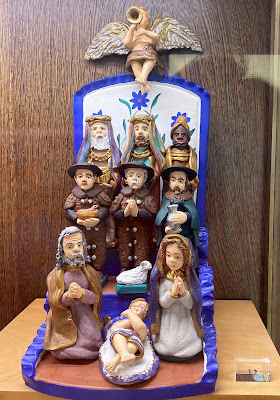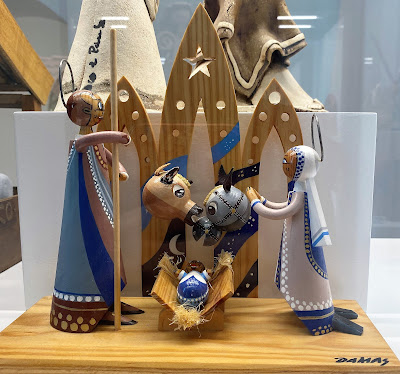July 2, 2022
Évora, yet another UNESCO World Heritage Site, was the last city on our list before returning to Lisbon, and there were a lot of things we wanted to see there. However, most of them were closed between 12:00 and 2:00 PM, so after parking our car we took a crazy, zig-zagging 12-minute walk through streets, alleys, and staircases, guided by the GPS on our phone.
We arrived at the Igreja São Francisco, or the St. Francis Church, not quite sure how we had gotten there.
There are twelve open chapels ringing the nave, each seeming more opulent than the last.
We saw this a lot in Portugal--the organ hung on the wall near the altar area.
And it wouldn't be Portuguese without at least one wall of stunning azulejo tiles.
But honestly, this would have probably been a somewhat forgetable church had it not been for three other sections we visited: the Chapel of Bones, the church museum, and the Nativity Scenes Collection.
On our way into the cathedral, I had purchased some homemade candy from a woman selling it outside.
I hadn't realized how much it looked like bones until we got to this part of the church.This chapel was literally constructed of bones in the early 17th century by Franciscan monks. The story goes that there were so many cemeteries in and around Évora that there wasn't enough farmland, so the monks relocated the bones to this chapel where they could help the townsfolk meditate on the value and transcience of the material world. A sign above the chapel door reads "We bones are here, waiting for yours."
There are two female "dessicated bodies" (aka mummies), one of which is a child, displayed in sweet repose in glass cases. If it said somewhere who they are, I didn't see it.
The focal point of the 61' x 36' room is a pretty altar NOT adorned with bones.
It's a little hard to see, but just outside the ossuary is a tiled wall with a rather odd modern line-drawing that appears to show scenes of birth and childhood.
I never grew tired of the many tile designs we saw absolutely everywhere in Portugal.
Outside the Bone Chapel there is also this stunning nativity scene that places the birth of Jesus in the city of Évora. There are 45 buildings that correspond to actual structures in town, and there are 564 human figures, animals, and various other objects.
Without question, however, my favorite part of the St. Frances Church is the museum, which is full of religious art.
Here are two versions of John the Baptist from the 17th and 18th centuries:
In this painting, St. John the Baptist (17th/18th century) is a child crowning the Lamb (of God--Jesus) with flowers.
The best part of the museum, without question, are galleries upstairs that contain hundreds of nativity scenes from the private collection of Major-General Fernando Canha da Silva and his wife Fernanda Canha da Silva. Devout Catholics, they greatly reverenced the Christmas holiday and began collecting nativities from local artists. As they traveled the world, they added more nativities from abroad. The have 2,600 nativities from over 80 countries. The collection was first displayed in 1999 in another location, but it found its permanent home in the St. Francis Museum Center in 2015. Less that a quarter of the total collection is on display, but even that many was slightly overwhelming!
I have a major love of nativity scenes and own several dozen myself that we have picked up on our travels. I was in heaven in the rooms that house this amazing collection.
It was hard, but I winnowed my photos down by about two-thirds for this post. Unless otherwise noted, they were made in Portugal.
 |
| From China |
.JPG) |
| From Italy |
.JPG) |
| From Cape Verde |
Unfortunately, I don't know the origin of the next two beautiful nativities. Somewhere in Africa?
We had a nice view of Évora when moving from one section to another.
I love the braying donkey is this one. Or is he singing "Hallelujah"?
I'll bet you've never seen an elf nativity before. This one on the left below came from Sintra, a magical city we visited at the beginning of our trip. The one on the right looks like it came out of a Tolkien book.
Back outside, where it was decidedly NOT Christmas.
Taking a rest before we try to find our car.


.JPG)
.JPG)
.JPG)














.JPG)
















.JPG)


.JPG)










.JPG)
.JPG)
.JPG)
.JPG)



.JPG)

.JPG)
.JPG)


.JPG)





.JPG)
.JPG)

.JPG)
.JPG)


A lot of that passed me by. I think I was worried about finding our car (which I assume is part of the next post). I'm glad you found nativity heaven.
ReplyDelete